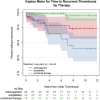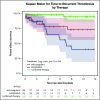Recurrent thrombosis in patients with antiphospholipid antibodies and arterial thrombosis on antithrombotic therapy
- PMID: 29296881
- PMCID: PMC5729618
- DOI: 10.1182/bloodadvances.2017008185
Recurrent thrombosis in patients with antiphospholipid antibodies and arterial thrombosis on antithrombotic therapy
Abstract
Management for patients with antiphospholipid syndrome (APS) and arterial thrombosis is controversial. There are no prospective data demonstrating the superiority of high- or moderate-intensity anticoagulation with vitamin K antagonists over antiplatelet agents. Using 2 antiphospholipid antibody databases (single center [New York Presbyterian Hospital] and multicenter [Antiphospholipid Syndrome Alliance for Clinical Trials and International Networking]), we retrospectively collected demographic and clinical data of patients with APS and arterial thrombosis. The primary outcome was recurrent thrombosis rate after initial arterial thrombosis in patients with APS treated with antiplatelet and/or anticoagulant therapy. We identified 139 patients with a median follow-up time of 4.24 years after initial thrombosis. Thirty-seven patients (27.3%) received anticoagulants, 43 (30.9%) antiplatelets, and 58 (41.7%) combined therapy. Sixteen patients (37.2%) in the antiplatelet group, 9 (23.7%) in the anticoagulant group, and 4 (6.9%) in the combined therapy group experienced recurrent thrombosis. We estimate that 20% of patients will experience a recurrence by 3.4, 7.3, and 16.3 years, respectively, depending on assignment to antiplatelet, anticoagulant, or combined therapy. These results suggest that combined therapy decreases the rate of and increases the time to thrombosis recurrence in patients with APS presenting with arterial thrombosis.
Conflict of interest statement
Conflict-of-interest disclosure: The authors declare no competing financial interests.
Figures
References
-
- Gómez-Puerta JA, Cervera R. Diagnosis and classification of the antiphospholipid syndrome. J Autoimmun. 2014;48-49:20-25. - PubMed
-
- Meroni PL, Borghi MO, Raschi E, Tedesco F. Pathogenesis of antiphospholipid syndrome: understanding the antibodies. Nat Rev Rheumatol. 2011;7(6):330-339. - PubMed
-
- Baker WF Jr, Bick RL, Fareed J. Controversies and unresolved issues in antiphospholipid syndrome pathogenesis and management. Hematol Oncol Clin North Am. 2008;22(1):155-174, viii. - PubMed
-
- Ruiz-Irastorza G, Cuadrado MJ, Ruiz-Arruza I, et al. . Evidence-based recommendations for the prevention and long-term management of thrombosis in antiphospholipid antibody-positive patients: report of a task force at the 13th International Congress on antiphospholipid antibodies. Lupus. 2011;20(2):206-218. - PubMed
-
- Lim W, Crowther MA, Eikelboom JW. Management of antiphospholipid antibody syndrome: a systematic review. JAMA. 2006;295(9):1050-1057. - PubMed
Grants and funding
LinkOut - more resources
Full Text Sources
Other Literature Sources
Miscellaneous



